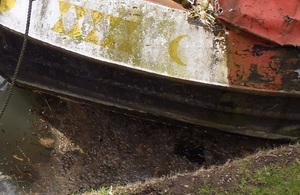Thames Water fined £1 million for pollution to Grand Union Canal
Thames Water Utilities Limited (Thames Water) has been ordered to pay record-breaking £1 million after polluting a canal in Hertfordshire.

This is the highest ever fine for a water company in a prosecution brought by the Environment Agency.
The case was brought by the Environment Agency after Thames Water caused repeated discharges of polluting matter from Tring STW (Sewage Treatment Works) to enter the Wendover Arm of the Grand Union Canal in Hertfordshire between July 2012 and April 2013.
In May Thames Water pleaded guilty before Watford Magistrates Court to two charges under the Environmental Permitting (England and Wales) Regulations 2010. On Monday 4 January, at St Albans Crown Court the company was ordered to pay a fine of £1 million, costs of £18,113.08 and a victim surcharge of £120.
Explaining why the fine was so large, HHJ Bright QC stated that:
The time has now come for the courts to make clear that very large organisations such as [Thames Water] really must bring about the reforms and improvements for which they say they are striving because if they do not the sentences passed upon them for environmental offences will be sufficiently severe to have a significant impact on their finances.
Thames Water has a permit to discharge treated effluent from Tring STW into the Wendover Arm of the Grand Union Canal. The conditions of the Environmental Permit set by the Environment Agency aim to prevent any negative impact upon the canal itself and activities such as boating and fishing which take place on or in it.
The court heard that poorly performing inlet screens caused equipment at the works to block, leading to sewage debris and sewage sludge being discharged into the canal. The inlet screens should take out the majority of sewage debris referred to as ‘rag’ from the process, but the screens had repeatedly failed in this case.
Partially treated sewage can contain polluting matter such as suspended solids, high levels of iron and aluminium. Suspended solids have the potential to smother organisms and plant life in rivers and cover the spawning grounds of fish. Aluminium and iron can have toxic impacts on macro-invertebrates. Routine samples of the discharge taken on 31 January 2013 contained high levels of iron and aluminium, and showed a high chemical oxygen demand.
Emily Rowland, Environment Officer for the Environment Agency, said:
We welcome the court’s decision to penalise Thames Water for serious breaches of its Environmental Permit, which led to pollution of the Grand Union Canal. We take these types of incidents very seriously and will do everything within our powers to safeguard the environment and people affected, and that includes holding to account those whose actions put the environment at risk.
The Environment Agency received complaints from the Canal and Rivers Trust and from the general public about pollution in the canal. Officers attended the site on several occasions, they saw sewage debris including panty liners and ear buds in the vicinity of the outfall. On one occasion officers worked with Thames Water, to arrange for aeration to be installed at the outfall into the Grand Union Canal, as a precautionary measure to increase the levels of oxygen in the water.
Thames Water explained to the court that it spent £30,000 on replacing the inlet screens at Tring. It co-operated with the Environment Agency in its investigation. It has taken steps to avoid further such incidents and there has been a significant improvement in its recent environmental performance. There was no financial motivation for or gain from the offences.
All media enquiries: 0800 917 9259, out of hours 0800 141 2743.